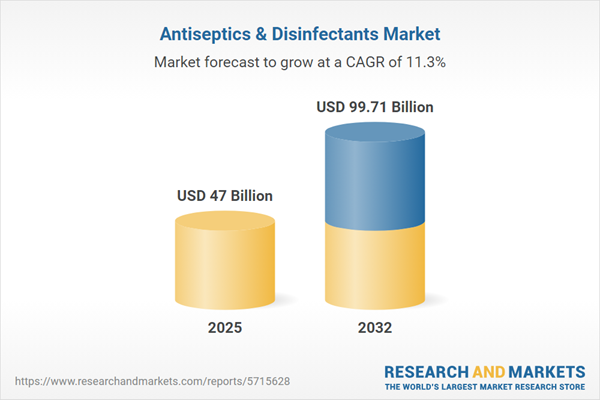Speak directly to the analyst to clarify any post sales queries you may have.
The antiseptics and disinfectants market is undergoing significant transformation, propelled by evolving biological threats, technological innovation, and growing regulatory scrutiny. Delivering potent infection control solutions, this market is instrumental for safeguarding public health across healthcare, commercial, industrial, and household settings.
Market Snapshot: Antiseptics & Disinfectants Market Growth Overview
The antiseptics and disinfectants market grew from USD 42.42 billion in 2024 to USD 47.00 billion in 2025. It is projected to achieve a CAGR of 11.27%, reaching USD 99.71 billion by 2032.
Scope & Segmentation: Defining the Antiseptics and Disinfectants Landscape
This report provides in-depth analysis and forecasting across critical market categories and regions, highlighting opportunities shaped by regulatory, technological, and application factors.
- Product Types: Includes alcohol-based agents (ethanol, propanol), aldehydes (formaldehyde, glutaraldehyde, ortho-phthalaldehyde), chlorhexidine solutions (acetate, gluconate, hydrochloride), chlorine compounds (calcium hypochlorite, sodium hypochlorite), hydrogen peroxide, iodine compounds (iodophors, povidone-iodine), organic acids (citric, lactic, malic), peracetic acid, phenolics (chloroxylenol, orthophenylphenol), quaternary ammonium compounds (benzalkonium chloride, cetylpyridinium chloride), and sodium perborate.
- Formulations: Foam, gel, liquid, powder, and wipes (disposable, reusable) enable customization for end-user operational needs.
- Spectrum of Activity: Addresses both broad-spectrum and narrow-spectrum antimicrobials tailored for multipurpose or targeted use.
- Applications: Encompasses enzymatic cleaners, hand sanitizers, surface disinfections (floors, walls, high-touch areas), and wound cleansing.
- End Users: Spans commercial (hotels, restaurants, shopping malls), healthcare (clinics, hospitals, laboratories), household, and industrial (agriculture, food processing, manufacturing, pharmaceuticals) sectors.
- Sales Channels: Includes offline retail (pharmacy stores, supermarkets) and online sources (company websites, major e-commerce platforms).
- Regions: Analysis covers Americas (North America, Latin America), Europe, Middle East & Africa (with key countries enumerated), and Asia-Pacific (major economies across East, South, Southeast Asia, and Oceania).
Key Takeaways for Decision-Makers
- Biological threat evolution and resistance emergence are prompting ongoing investment in advanced antimicrobial chemistries and delivery systems by key manufacturers.
- Regulatory changes and stricter frameworks are driving the shift toward innovation, life-cycle assessment, and sustainable ingredient sourcing.
- Technology adoption, such as digital monitoring and IoT-enabled dispensers, is streamlining hygiene management, compliance tracking, and predictive maintenance for better resource allocation.
- Rising demand for eco-friendly products is accelerating the integration of biodegradable actives and recyclable packaging throughout the product lifecycle.
- Regional dynamics shape demand: the Americas prioritize high-performance solutions and compliance, EMEA requires flexible supply strategies due to regulatory diversity, and Asia-Pacific leverages growth in infrastructure and digital solutions to drive adoption.
- Strategic partnerships, including public-private collaborations, research alliances, and contract manufacturing, play a crucial role in penetrating underserved markets and enhancing operational resilience.
Tariff Impact and Global Supply Chain Considerations
Recent US tariffs have impacted supply chains, compelling manufacturers to diversify raw material sourcing, optimize production processes, and evaluate nearshoring or regional distribution center models. These adjustments help offset cost pressures and ensure continued access to critical inputs amid evolving trade policies.
Methodology & Data Sources
Findings are based on structured interviews with industry executives, regulatory stakeholders, and supply chain experts, combined with data from proprietary trade databases, published industry reports, academic research, and a thorough review of regulatory filings and patent activity. Rigorous cross-verification and iterative analysis strengthen the reliability of all market estimates and trend projections.
Why This Report Matters
- Enables senior leaders to anticipate regulatory trends, optimize product portfolios, and identify new growth segments through robust, data-driven market intelligence.
- Equips procurement, operations, and innovation teams to develop resilient sourcing strategies and accelerate sustainable product development in an increasingly complex landscape.
- Supports strategic planning with actionable insights into regional opportunities, competitive positioning, and evolving technological frameworks.
Conclusion
The antiseptics and disinfectants market is rapidly evolving, influenced by emergent biological risks, technological progress, and regulatory mandates. Organizations equipped with comprehensive, reliable insights are positioned to drive growth, innovation, and operational resilience in this dynamic environment.
Additional Product Information:
- Purchase of this report includes 1 year online access with quarterly updates.
- This report can be updated on request. Please contact our Customer Experience team using the Ask a Question widget on our website.
Table of Contents
3. Executive Summary
4. Market Overview
7. Cumulative Impact of Artificial Intelligence 2025
Companies Mentioned
The companies profiled in this Antiseptics & Disinfectants market report include:- 3M Company
- BASF SE
- ABC Compounding Co., Inc.
- Amway Corporation
- Angelini Pharma S.p.a.
- Arcadia Consumer Healthcare
- Becton, Dickinson, and Company
- Cardinal Health, Inc.
- Certified Safety Manufacturing, INC.
- Colgate-Palmolive Company
- Ecolab Inc.
- Henkel AG & Co. KGaA
- Johnson & Johnson Services Inc
- Kemin Industries, Inc.
- Kimberly-Clark Corporation
- Lanxess AG
- Lonza Group Ltd.
- Medline Industries, LP
- Microgen Hygiene Pvt. Ltd.
- Procter & Gamble Company
- Reckitt Benckiser Group PLC
- Schülke & Mayr GmbH
- Solenis LLC
- Steris PLC
- The Clorox Company
- The Dow Chemical Company
- Unilever PLC
- Whiteley Corporation
Table Information
| Report Attribute | Details |
|---|---|
| No. of Pages | 185 |
| Published | November 2025 |
| Forecast Period | 2025 - 2032 |
| Estimated Market Value ( USD | $ 47 Billion |
| Forecasted Market Value ( USD | $ 99.71 Billion |
| Compound Annual Growth Rate | 11.2% |
| Regions Covered | Global |
| No. of Companies Mentioned | 29 |









